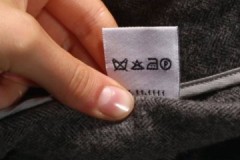Tips from experienced laundresses on how to wash things by hand
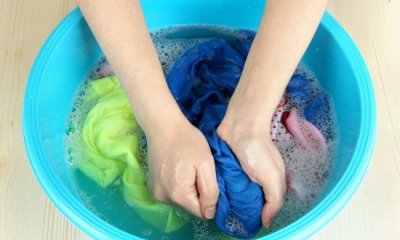 Hand washing is not as popular as automatic washing. But in some cases you cannot do without it. You can wash an item by hand effectively and efficiently if you know all the features of this processing process.
Hand washing is not as popular as automatic washing. But in some cases you cannot do without it. You can wash an item by hand effectively and efficiently if you know all the features of this processing process.
Let's take a closer look at how to properly wash clothes and linen by hand, what washing products to use, whether you need to wring things out, and how to dry them.
Content
In what cases is hand washing preferable to machine washing?
When caring for your items, hand washing can be a conscious choice or a necessity. An indication that processing should be done by hand can be found on the product label.
The following categories of things should also not be placed in the machine:
 having significant wear and tear;
having significant wear and tear;- with contaminants that can damage the washing unit - contaminated with kerosene, gasoline, machine oil and other chemicals;
- leather and leatherette products;
- thin lace items;
- products with complex decor;
- products that have a rigid shape or frame (corsets, hats, etc.).
Manual processing has much fewer restrictions compared to machine processing, as it allows you to vary the intensity of the impact.
Exceptions include products for which dry cleaning only is permitted.For example, coats, hats and other similar products. All other things can be put in order by hand.
Preparation for processing
Before you put things in the water, it is necessary to go through the preparatory stages:
- Preparation of the workplace.
- Choosing a detergent.
- Determination of detergent for each specific case.
- Selecting water temperature.
- Sorting things.
Workplace organization
When starting to wash by hand, you should take care of the following things:
 container (basin);
container (basin);- detergent;
- clothespins;
- trempel;
- hangers with special clips for drying trousers;
- air conditioner;
- latex gloves.
For ease of processing, it is desirable that there are two basins, not one. One is for washing, and the second is for rinsing.
If possible, then The workplace should be organized so that you do not have to constantly bend over too much. When washing in an awkward position, you can quickly get tired.
The presence of rubber gloves will reliably protect your hands from prolonged contact with household chemicals and water. If they are not used, cracks and irritation may occur on the skin.
Sorting laundry
As with machine washing, manual processing requires sorting of products. In this case, you should adhere to the following rules:
- Delicate fabrics should not be washed with rough materials.
- Black things - process separately from others, white - Same.
- Shedding products are processed separately from all other products.
How to choose the right detergent?
The selection of detergent should take into account the color and composition of the fabric. For most products, it is recommended to use detergents in the form of gels rather than powders.
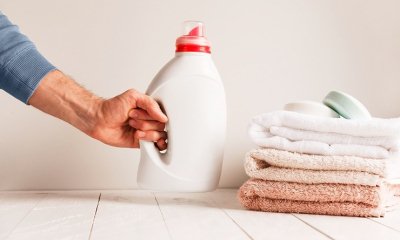 Such drugs have a number of advantages:
Such drugs have a number of advantages:
- faster dissolution in water when compared with granular formulations;
- uniform distribution in water;
- no sediment;
- good dissolution in water of any temperature (powders are easier to dilute in warm or hot water, and more difficult in cold);
- good rinsing from fabric fibers.
Careful dilution of the powder is a must. If it is violated, damage to the washable material may occur due to the contact of undissolved concentrated granules.
For some types of products, special products are produced designed for washing wool, delicate fabrics, etc.
A good result from washing can be obtained if choose a product based on the color of the material:
- for black;
- for white;
- for colored.
The use of chlorine bleaches is not advisable for a number of reasons:
- Chemical vapors inhaled during washing are harmful to health.
- Can be used with restrictions only on white cotton fabrics.
- Use leads to thinning of the fibers, loss of appearance, rapid wear and tear.
The simplest and most affordable laundry detergent is laundry soap. Its use is not advisable for automatic washing, but is suitable for manual processing. Another plus is that the composition is hypoallergenic, allowing you to use soap for washing underwear and baby clothes.
Pre-soaping most items makes washing later much easier.
Water heating temperature
The water temperature is determined based on the permissible temperature for a particular product, and taking into account the fact that it should be tolerable for the hands - no more than +50? C. If there is no label on the item, then The water temperature is determined by the type of material:
 natural linen And cotton it is possible to process at almost any temperature, but more often - about +40? C;
natural linen And cotton it is possible to process at almost any temperature, but more often - about +40? C;- wool and natural silk – from +30?С to +40?С;
- viscose – up to +30?С;
- synthetics - +40? C;
- mixed materials – up to +40?С or +50?С.
If it is impossible to determine the composition, it is advisable to choose a temperature of +30 - +35? C for washing.
Instructions
Having a basic knowledge of hand washing, you can begin processing according to the following scheme:
- Determine a place for washing things. It is advisable that it be located in close proximity to a water source.
- You need to pour water at the required temperature into the washing container.
- Dilute the detergent in water according to the instructions on the package.
- Stir the soap solution until foam forms and the detergent is completely dissolved.
- Dip things in water.
- If there are particularly dirty places, they need to be rubbed with soap.
- If things are dirty, they can be left in the basin for up to 20 minutes. In case of significant contamination, cotton items can be soaked for up to 3 hours, and bed linen and kitchen towels for up to 6 hours.
- Rub contaminated areas.
- Squeeze things out a little.
- If you use 2 basins, then transfer things to the second one.
- Drain the dirty water from the first one.
- Take warm water and rinse.
- Take cold water and rinse.
Hand-wringing clothes: necessary or not?
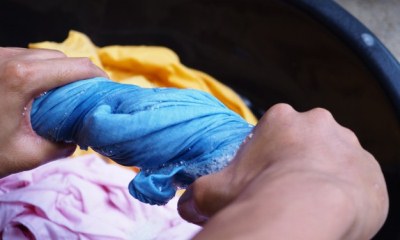 After rinsing, items should be wrung out. Twisting must be avoided so as not to deform the product.
After rinsing, items should be wrung out. Twisting must be avoided so as not to deform the product.
During the spin process, try to remove as much water as possible.. For delicate fabrics, the method of squeezing items through a terry towel is suitable.
For some types of materials, thin and delicate, such as chiffon, polyester, it is better to exclude the spin cycle and simply allow the water to flow over the bathtub.
How to clean bulk items?
Bulky products such as parkas and jackets, can be washed using various methods:
- Washing only certain areas of the top layer of fabric.
- Full processing.
Difficulty in washing large items:
- the volume of the thing itself;
- significant weight gain when wet;
- difficulties with spinning and drying.
For cleaning use a sponge or soft brush. It is convenient to rinse off soapy water using a shower head, directing it from top to bottom.
If a jacket or other bulky item needs to be washed entirely, you will have to do it right in the bathroom. Hand washing in this case will be very labor-intensive. A wet item should be processed zone by zone, carefully turning it over.
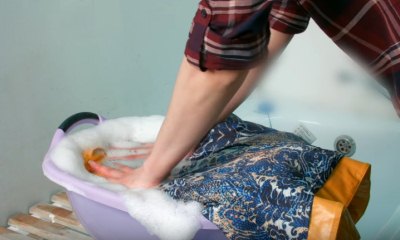 After washing, a product saturated with water requires very careful further processing. Otherwise, the insulation may become deformed, unevenly distributed and disrupt the shape of the entire thing.
After washing, a product saturated with water requires very careful further processing. Otherwise, the insulation may become deformed, unevenly distributed and disrupt the shape of the entire thing.
To prevent this from happening, you should allow the bulk of the water to drain directly into the bathroom. And only after that proceed to drying.
Drying bulky items should be carried out by turning and repositioning the product, ensuring uniform drying.
Folk recipes for cleaning compositions
Folk laundry detergents can be a good alternative to household chemicals. They are based on available ingredients and simple technology for preparing cleaning compositions.
Mustard
The use of natural mustard allows for careful, delicate washing of items, including those made of natural silk and wool.
For manual processing you will need:
- 3 l. water;
- 3 tbsp. mustard powder.
Processing order:
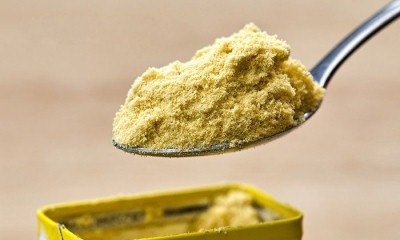 Pour water into the container.
Pour water into the container.- Dissolve the mustard.
- Leave for 120 minutes.
- Strain the solution.
- Pour it into a bowl of hot water.
- The remaining mustard should be poured again into 3 liters. water.
- Things are washed in a water infusion of mustard.
- During the last rinse, you can add 1 tbsp to the water. l. vinegar per 1 liter. liquids. For wool – 1 tsp. ammonia per 1 liter. liquids.
Soda ash - for flax and cotton
This product has good effectiveness when processing linen and cotton items.
Cons of soda:
- inability to use wool and silk for washing;
- impossibility of use for processing fading fabrics.
For greater effect, use a short pre-soak for 10-15 minutes.
Homemade gel
For 1 l. water:
- grate 50 grams of laundry soap;
- soda ash – 50 grams or regular table soda – 200 grams;
- essential oil (for aromatization) – 7 drops.
Cooking process:
 Bring water to a boil.
Bring water to a boil.- Add soap shavings.
- Add soda.
- Stir until the soap is completely dissolved.
- Remove from heat. As it cools, the mixture will thicken, acquiring a gel concentration.
- After the mixture has cooled, add essential oil and mix again.
The gel is used at the rate of 2 tbsp. l. for one basin of water with washing. Store the washing gel in a tightly closed container. Before use, it is advisable to stir the composition so that it becomes homogeneous.
Salt solution for calico
The salt-based recipe is suitable for washing items made from natural fabrics based on plant materials - linen and chintz.
Procedure:
- Immerse the products in clean water for a quarter of an hour.
- Drain the water, put things aside.
- Dial 5 l. water.
- Add 5 tbsp. l. kitchen salt.
- Stir until the salt is completely dissolved.
- Dip things in water.
- Leave for 60 minutes.
- Rinse as usual after washing.
The method is only suitable for natural fabrics made from plant materials.
Beans for sweaters
What you need as a detergent is not the beans themselves, but the infusion. Preparation procedure:
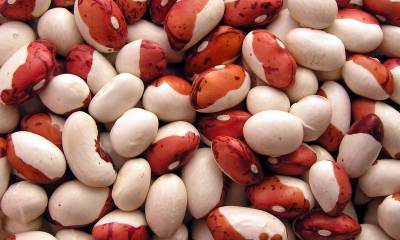 in 1 l. soak 0.2 kg of beans in water;
in 1 l. soak 0.2 kg of beans in water;- cook until the beans are ready;
- strain the liquid through cheesecloth;
- add the decoction to a bowl of water intended for washing;
- beat the washing solution by hand;
- wash as usual;
- rinse.
Bean decoction makes woolen items soft and fluffy.
Soap nuts
This is a natural product that comes from Asia. You can buy it in eco-goods stores. All you need for washing is a nut shell.
Procedure:
- Place 10 shells in a washing bag.
- The bag is placed in the basin.
- Pour hot water.
- Leave for a quarter of an hour, periodically kneading the contents of the bag.
- Dipping things into a basin.
- Leave things for 15-20 minutes.
- Start washing by hand.
- After washing, items should be rinsed.
This product is suitable for treating children's clothing, underwear for allergy sufferers and for those with dermatological diseases.
Proper drying
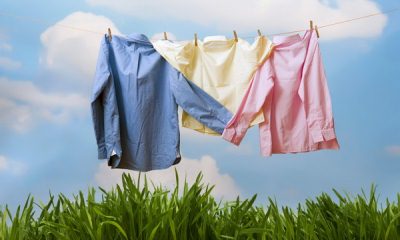 It is recommended to dry any items in a well-ventilated area or outside.
It is recommended to dry any items in a well-ventilated area or outside.
How best to position an item for drying depends on the material, type of clothing, and size:
- blouses, shirts - on trempel;
- bedding - thrown over a rope;
- woolen and acrylic sweaters and pullovers - unfolded, etc.
You can read about all the features of drying hand-washed items Here.
13 recommendations
Hand washing in most cases is not difficult. Its main disadvantage is the laboriousness of the process.
To make processing as easy as possible, you should use the following recommendations:
- When washing a fading item, the water must be changed more often and not used for caring for other items.
- If washing is done with laundry soap, it can be used in two forms - by grating it into shavings or by placing a whole piece in warm water prepared for washing.
- Using detergents that match the color and type of fabric will extend the life of the products.
- If the product is very dirty, then after soaking the water must be drained and fresh water must be collected, in which the detergent must also be dissolved. In this case, soaking is carried out in one water, and washing in another.
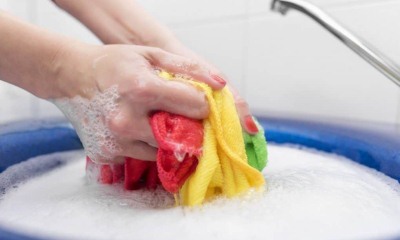 To reduce the number of rinses, the water from the item should be squeezed out well after each rinsing stage.
To reduce the number of rinses, the water from the item should be squeezed out well after each rinsing stage.- For allergy sufferers, the washing agent should be one that is marked “hypoallergenic”. Laundry soap and detergents for washing children's clothes are also suitable.
- A brush with soft bristles can be used to wash thick fabrics.
- For washing small items, it is convenient to use basins of compact shape and size.
- Before washing, dirty items should not be stored for a long time, as this will make them difficult to wash.
- It is advisable to wash some items inside out. For example, woolen ones, as well as those that have large decor on the front side.
- A poorly rinsed item should not be sent to dry. If you do this, you can get unsightly stains on the material, deterioration in the softness of the item, damage to the fibers, and irritation on the skin upon contact with such products.
- A wide basin is more convenient for washing than a narrow one.
- The inclusion of protein-decomposing enzymes in the detergent is prohibited for washing items made from natural wool and silk.
You will find maximum useful information about washing clothes and various fabric products Here.
Video on the topic of the article
This video will show you how to wash by hand correctly:
Conclusion
The ability to properly wash things by hand is a useful skill that will help you cope with laundry when your washing machine breaks down or in situations where it is impossible to clean the item otherwise.
Wherein it is important to follow the entire sequence of actions, preparing the workplace and detergent for washing. The knowledge gained will help simplify the hand washing process without losing the quality of processing.
